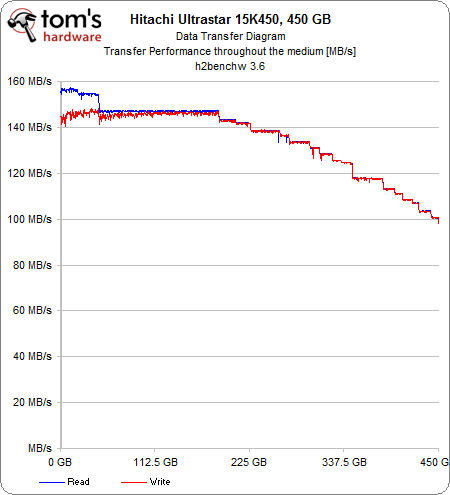SAS Storage: High-Performance Hard Drives
Test Setup and Transfer Diagrams
| Processors | 2x Intel Xeon Processor (Nocona core) |
| 3.6 GHz, FSB800, 1 MB L2 Cache | |
| Platform | Asus NCL-DS (Socket 604) |
| Intel E7520 chipset, BIOS 1005 | |
| RAM | Corsair CM72DD512AR-400 (DDR2-400 ECC, reg.) |
| 2x 512 MB, CL3-3-3-10 timings | |
| System Hard Drive | Western Digital Caviar WD1200JB |
| 120 GB, 7,200 RPM, 8 MB Cache, UltraATA/100 | |
| Mass Storage Controllers | Intel 82801EB UltraATA/100 Controller (ICH5) |
| Adaptec 48300 SAS controller | |
| Networking | Broadcom BCM5721 On-Board Gigabit Ethernet NIC |
| Graphics | On-Board Graphics |
| ATI RageXL, 8 MB |
| Performance Measurements | c’t h2benchw 3.6 |
| PCMark05 V1.01 | |
| I/O Performance | IOMeter 2003.05.10 |
| Fileserver Benchmark | |
| Webserver Benchmark | |
| Database Benchmark | |
| Workstation Benchmark |
| OS | Microsoft Windows Server 2003 Enterprise Edition, |
| Service Pack 1 | |
| Platform Driver | Intel Chipset Installation Utility 7.0.0.1025 |
| Graphics Driver | Default Windows Graphics Driver |
The Ultrastar 15K450 has an impressive transfer diagram, as the drive manages to maintain a very high throughput of almost 150 MB/s over almost half of the drive’s surface. This means that the drive is capable of reading or writing at 140 MB/s as long as you do not utilize more than 200 GB of capacity. Even if you start utilizing more capacity, the transfer rates typically do not drop much below 100 MB/s, which is an excellent result. Most flash based SSDs can reach that, but they don’t provide the maximum of almost 160 MB/s.
Seagate’s Cheetah 15K.6 transfer diagram is more conventional. The drive delivers almost 175 MB/s at the beginning of the medium, and goes down to still over 100 MB/s when you utilize the entire 450 GB. While there are more steps than in Hitachi’s Ultrastar 15K450 diagram, the Seagate drive still manages to provide better throughput than the Hitachi drive in all areas of the medium. This is the fastest mechanical drive we’ve had in our test lab—it’s definitely well faster than flash SSDs when it comes to sequential throughput. Congratulations to Seagate.
Get Tom's Hardware's best news and in-depth reviews, straight to your inbox.
Current page: Test Setup and Transfer Diagrams
Prev Page Seagate Cheetah 15K.6 Next Page Access Time and Interface Bandwidth: h2benchw 3.6
